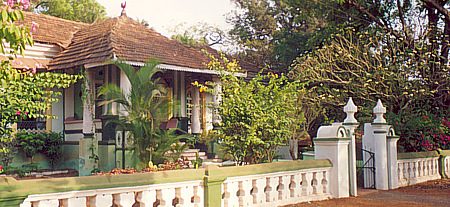‘Mirabai’ – the inspiration behind Maendra Alvares’s Ancestral Goa
Almost 22 years ago, in 1983, Maendra Jocelino Araujo Alvares, decided to tread a path untrod. He single-handedly sculpted a monolith of gigantic proportions – that of ‘Sant Mirabai’. Maendra finished sculpting the masterpiece within a record 34 days. Chiselled out of a single laterite rock that existed on their family property in Khattem, Goa. This piece of art lies within the walls of his Museum Ancestral Goa or ‘Bigfoot’ as it is famously called. From then on, there was no turning back for Maendra Alvares.

How did ‘Big Foot’ get its name?
Ancestral Goa houses many wonders. One of them is especially noteworthy – that of a big footprint in existence atop a rock. The footprint is quite large, preserved in a temple-like cave inside Ancestral Goa.

Besides, they have a designer dance floor The ‘Big Foot’, Goa’s biggest dance floor shaped like a giant foot and has been created for the express purpose of being a versatile venue for all types of functions and entertainment events like weddings, anniversaries, seminars, dances etc. The Big Foot dance floor measures 40 mts. by 18 mts. and a comfortable number of 2,500 people can be accommodated in the 9,000 sq. meter area. (Information: Ancestral Goa)
What is Ancestral Goa?
Ancestral Goa showcases colourful, life-size figures depicting Goa’s traditions, lifestyle, occupations, modes of transport, celebrations etc. of an era gone by. The harmonious Village life lived by different communities that co-existed at that time is beautifully portrayed. Real implements and tools of the different trades and crafts are displayed alongside.

Celebrations:


Occupations:





Casa Araujo Alvares is the heritage home of the Alvares family. Situated across the road from ‘Big Foot’ Museum, the house has been preserved unlike most ancestral homes in Goa. Maendra and his brothers have painstakingly preserved and collected antique curios, implements, artifacts etc. that belonged to the Colonial era of Goa. Right from farm tools, to furniture, utensils etc. All showcased in Casa Araujo Alvares. Maendra also has his own museum of holy-crosses on display.

Ancestral Goa has won many awards including entering the Limca Book of Records for ‘Mirabai’. It is recommended for students as a ‘Very Educative Center’ by the State Education Department.
Open all days – From 9:00 am to 1:00 pm and 2:00 pm to 5:30 pm
Entry fee: Rupees 150 per person for the Museum plus Rupees 20 for use of camera. Separate fee of Rs.300 for the Ancestral house – Casa Araujo Alvares


